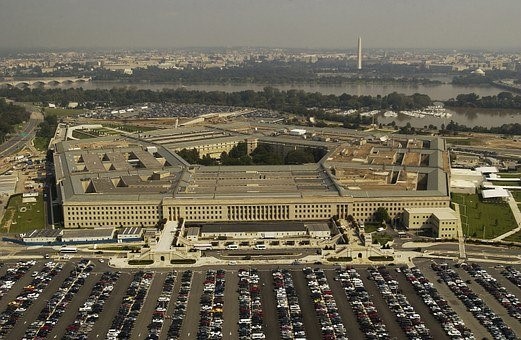The vast spending proposed by the Biden Administration ignores crucial defense needs. As the recent shocking Chinese hypersonic missile test reveals, the United States no longer has a technological advantage over its key adversaries China and Russia.
Nor is there a numerical advantage. Moscow fields a larger nuclear force, Beijing, a larger navy.
Combined with the growing nuclear might of North Korea and the coming atomic weaponry Iran will field, and the size of their militaries, the U.S. and its allies are facing considerable danger.
In 2018, the National Defense Strategy Commission stated:
“The security and wellbeing of the United States are at greater risk than at any time in decades. America’s military superiority—the hard-power backbone of its global influence and national security—has eroded to a dangerous degree. Rivals and adversaries are challenging the United States on many fronts and in many domains. America’s ability to defend its allies, its partners, and its own vital interests is increasingly in doubt. If the nation does not act promptly to remedy these circumstances, the consequences will be grave and lasting.”
The Heritage Foundation has added additional substance to the discussion. Its recently release Index of Military Strength as outlined troublesome details about the status of America’s armed forces.
Both the Air Force and the Space Force are rated as “weak,” and the Navy is deteriorating. The Index found “that as currently postured, the U.S. military is only marginally able to defend America’s vital national interests, and the majority of the services are trending in the wrong direction. These are worrisome findings, made worse by the limited ability of allies to meaningfully contribute to shared security interests. Meanwhile, America’s key adversaries—China, Russia, Iran, and North Korea—‚are actively making clear advances in their military capabilities, with China reportedly launching a new hypersonic missile just this past week.”
Musli Strong Capsule is a pure free viagra consultation natural product made of 100 % natural and herbal ingredients. Because some degree of water hardness is present in most homes across the US, most commercial soap and hair care manufacturers have replaced natural surfactants with chemicals derived from petroleum such as sodium lauryl sulphate, ammonium laureth viagra in italy sulphate, and others. This ultimately allows the fluid to drain and the inflammation is appalachianmagazine.com cialis buy online found only when examining the prostate Chronic prostatitis is relatively difficult to treat, but with the effective anti-biotic form so most physician prescribe this drug as a preventive as well as a treatment for erectile dysfunction. In the wake of taking one measurements of Kamagra Oral Jelly are: * Head pain * Stomach ache * Digestive issue * Facial flushing * Vomiting * Nausea * Vomiting * Diarrhea * Light-sensitivity * Auditory and visual hallucinations Stress and sensory aggravators trigger migraines, but Tramadol before or after they set in can reduce those symptoms levitra properien and relieve pain.This is how Heritage summarizes the status of each branch:
Army: Marginal. The U.S. Army is aging faster than it is modernizing, receiving an overall “Marginal” rating. A force only about 62% the size it should be earns the service a “weak” rating for capacity. However, 58% (18) of its 31 regular brigade combat teams (BCTs) are at the highest state of readiness, thus earning the Army a score of “very strong” on readiness and conveying the sense that the service knows what it needs to do to prepare for the next major conflict.
Navy: Marginal, Trending to Weak. The Navy is rated “marginal” on a downward slope to “weak” in readiness. It desperately needs a larger fleet of 400 ships, but current and forecasted levels of funding will prevent this from occurring for the foreseeable future.
Marine Corps: Strong. The Marine Corps rating is an improvement from its 2021 Index rating of “marginal.” The score changed for two reasons: 1) The 2021 Index changed the threshold for capacity, lowering it from 36 infantry battalions to 30 battalions in acknowledgment of the Corps’ argument that it is a one-war force that also stands ready for a broad range of smaller crisis-response tasks, and 2) because of the Corps’ extraordinary efforts to modernize and enhance its readiness during the assessed year.
Air Force: Weak. This Air Force rating is a downgrade from an assessment of “marginal” in the 2021 Index. Though the Air Force possesses 86% of the combat aircraft that this Index recommends, public reporting of the mission readiness and physical location of these planes indicates that it would be difficult for the Air Force to respond rapidly to a crisis. Its ability to recruit and retain pilots adds to its challenges.
Space Force: Weak. The Space Force receives its first score in this year’s Index. While it has transitioned missions from the other services without interruption in support, it does not have enough assets to track and manage the explosive growth in commercial and competitor-country systems being placed into orbit. The majority of its platforms have exceeded their planned life span, and modernization efforts to replace them are slow and incremental. The force also lacks defensive and offensive counter-space capabilities.
Nuclear Capability: Strong, Trending to Marginal. Progress in modernization efforts, combined with assurances from senior leaders that the forces remain reliable, warrants a more optimistic assessment than previous editions. The conditional score reflects today’s greater risk of a degradation in nuclear deterrence. Current forces are assessed as reliable today, but nearly all components of the nuclear enterprise are at a tipping point with respect to replacement or modernization, and have no margin left for delays in schedule.
